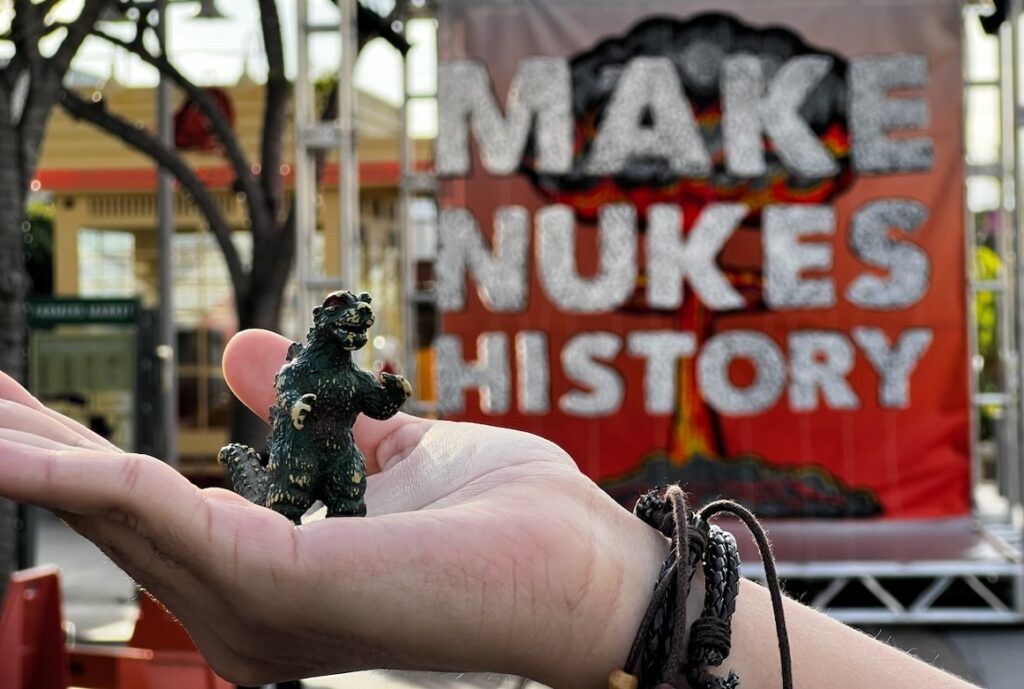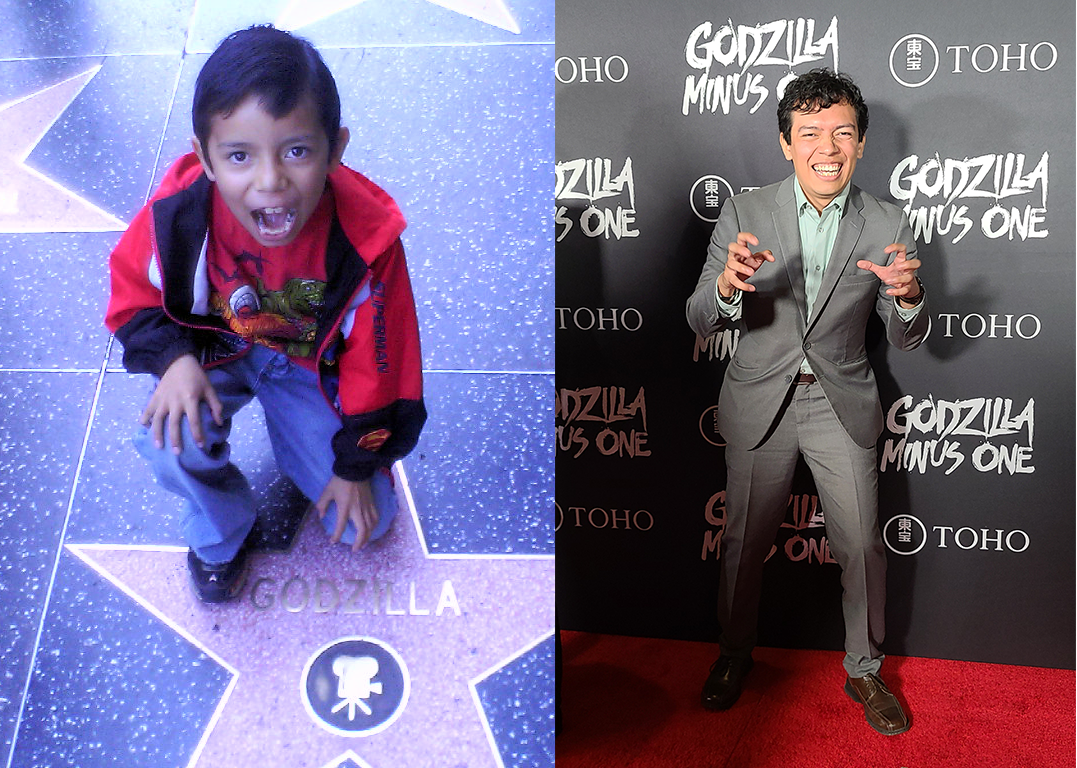I’m an immigrant antinuclear activist. Here’s why I love Godzilla
By Cristopher Allan Cruz Colorado | March 22, 2024
 This tiny toy Godzilla, given to the author as a child, has traveled with him to conferences and antinuclear events around the world. Credit: Adam Foskey/TaskForce
This tiny toy Godzilla, given to the author as a child, has traveled with him to conferences and antinuclear events around the world. Credit: Adam Foskey/TaskForce
On November 10, 2023, I had an opportunity to attend the red-carpet premiere of Godzilla Minus One in West Hollywood. As a young Salvadoran-American living in South Los Angeles and a longtime Godzilla fan, I had only dreamed of attending such an exclusive event, filled with high-profile guests and artists respected by the Godzilla fandom.
Afterward, I got to ask Takashi Yamazaki—the film’s director, writer, and visual effects chief—about his influences, which included some of my own favorites among the dozens of Japanese films about a giant prehistoric reptile brought back to life by nuclear radiation. I also participated in an interview with the Japanese press about my experiences working in nuclear disarmament and my reactions to the movie.
Yamazaki set out to make the 37th installment in the Godzilla franchise as an epic that delves into the horrors of war. Released in Japan on the 70th anniversary of the original film, Godzilla Minus One follows a former kamikaze pilot suffering from survivor’s guilt. While most of the English-speaking media focused on the massive Oppenheimer sweep at the Oscars earlier this month, the sleeper hit from Japan has amassed even higher ratings than Oppenheimer, garnered critical accolades (including an Oscar for Best Visual Effects), and boosted box office earnings around the globe in a way that can only be described as a kaiju-sized rampage.
But little did director Yamazaki realize that his epic would resonate deep within the heart of a 23-year-old immigrant antinuclear activist in Los Angeles.
Growing up with Godzilla. I was born in San Salvador, El Salvador, to parents who were survivors of a 12-year civil war funded in large part by the two biggest nuclear powers of the 1980s, the Soviet Union and the United States, my adoptive country. When my mother and I arrived in Los Angeles in 2003, I carried a small, red backpack filled with dinosaur toys my Salvadoran neighbors gave me—among them was a tiny, green monster with silver spines. After visits to the local library near my new home in South Los Angeles and conversations with newfound friends at school, I came to realize that the little monster in my backpack was none other than Godzilla.

What could have become only a passionate hobby ended up leading me down a rabbit hole of nuclear weapons history and policy.
I remember borrowing copies of the first Godzilla movie (released in 1954 as the Japanese-language Gojira) from my local library, watching clips from the 1998 cartoon series, and reenacting monster battles with my best friend in first grade. Also, I vividly remember stumbling upon a man reading aloud to his daughters at the Riordan Library in downtown Los Angeles about Godzilla’s origin as an antinuclear response to the 1945 nuclear attacks on Hiroshima and Nagasaki, Japan. That incident at the library filled me with curiosity about nuclear weapons.
In 2017, my nascent interest in nuclear technology developed further at the Critical Issues Forum, a nuclear education conference for high school students. I was one of two US Latino students who flew to Nagasaki to talk about the Comprehensive Nuclear Test Ban Treaty. Months before, I had seen the first Japanese Godzilla movie produced in 12 years, Hideaki Anno’s Shin Godzilla. Nuclear testing, waste, and disarmament were in the back of my mind as I marched forward into the world of nuclear policy.
When I traveled to Japan, Austria, and South Korea during the past seven years—representing the United States and talking about the importance of young, non-white voices in the nuclear field—I brought along my tiny Godzilla from El Salvador, now christened SalvaGoji, as a reminder of my own humble beginnings.
Stranger than fiction. Godzilla catapulted me into a world that is stranger than fiction, and he gives me confidence and perseverance to keep working on the pressing issue of nuclear disarmament. For those who don’t know, Godzilla is like Superman: There are only a handful of ways you can kill him, so he’s essentially invulnerable and immortal.
When I’m not campaigning against nuclear weapons at the United Nations in Vienna, or myth-busting the latest State Department news to my family at the dinner table, I still find time to enjoy Godzilla culture. After I saw Godzilla Minus One at the premiere, I saw the movie two more times in theaters, once in 4DX (with motion seats) and another time in black and white. The action was incredible, the drama was gripping, and the monster was glorious in all of his atomic fury. Viewers who were expecting another silly romp instead met face-first with the giant dinosaur’s nuclear breath in a way that pays homage to the franchise’s original 1954 film, a staple of nuclear satire.
Godzilla Minus One values the cooperative efforts of humanity against existential threats. And because the film takes place in post-war Japan, it also criticizes senseless wars in which the victims are not the people in charge of declaring war, but instead are the mundane citizens who get caught in the literal crossfire—like my parents in El Salvador. Some scenes from the movie are a cinematic marvel but also harken back to images of Hiroshima and Nagasaki like those I saw when I toured the Nagasaki Atomic Bomb Museum in 2017. There I came face to face with wood planks containing the remains of vaporized humans, human remains encrusted in melted glass, and the hibakusha who survived the atomic bomb.
Next week, the 38th film in the Godzilla franchise will open in Los Angeles. Godzilla x Kong is an American film with a completely different tone, style, and subject than Godzilla Minus One—more Barbie than Oppenheimer. It is being marketed as a light-hearted CGI action fest. Like the four other American Godzilla movies that preceded it, the new installment is unlikely to grapple seriously with the themes of American nuclear imperialism and contamination in a way that builds off the original or Shin Godzilla and Godzilla Minus One.
Walking away from the Hollywood premiere of Godzilla Minus One in November, I felt like I had peaked as a Godzilla fan. But in the realm of nuclear policy, the arms race is ramping up, treaties are being challenged if not ultimately abandoned, and the pool of professional opportunity is now drying up. It is difficult to remain committed to a nuclear-weapons-free vision, but there is a glimmer of hope.
As Japanese cinema reinvigorates the metaphor that is Godzilla, the United Nations is revitalizing efforts to bring member states closer to a world without nuclear weapons. I’m happy to have joined this work, and I thank Godzilla for igniting the passion that has led me down this path.
Together, we make the world safer.
The Bulletin elevates expert voices above the noise. But as an independent nonprofit organization, our operations depend on the support of readers like you. Help us continue to deliver quality journalism that holds leaders accountable. Your support of our work at any level is important. In return, we promise our coverage will be understandable, influential, vigilant, solution-oriented, and fair-minded. Together we can make a difference.
Keywords: Godzilla, Los Angeles, nuclear disarmament
Topics: Nuclear Weapons, Opinion, Voices of Tomorrow















Dear Cristopher, No nukes y’all from Georgia! What an enjoyable, thoughtful, inspiring article. I also have adopted Godzilla as anti-nuclear mascot Your tiny Godzilla is so cool. I am writing to invite you to consider that Godzilla may be “she”!
Hi Glenn, how thoughtful of you!
SalvaGoji says hello from our work desk and thanks you for the support!
Regarding Godzilla’s gender identity, here are a few things worth reading:
https://en.wikipedia.org/wiki/Godzilla#:~:text=In%20the%20original%20Japanese%20films%2C%20Godzilla%20and,Godzilla%20is%20referred%20to%20as%20a%20male
https://wikizilla.org/wiki/Godzilla_misconceptions#:~:text=body%20begins%20regenerating.-,Is%20Godzilla%20male%20or%20female%3F,-A%20U.S
I am not Toho nor the King of Monsters, so who am I to say what Godzilla’s preferred pronouns are ¯\_(ツ)_/¯.
There are a handful of other monsters in the Godzilla franchise that are female like the benign Mothra, for example, or the nefarious Hedorah (the Smog Monster) and Biollante (Rose-Godzilla Hybrid)!